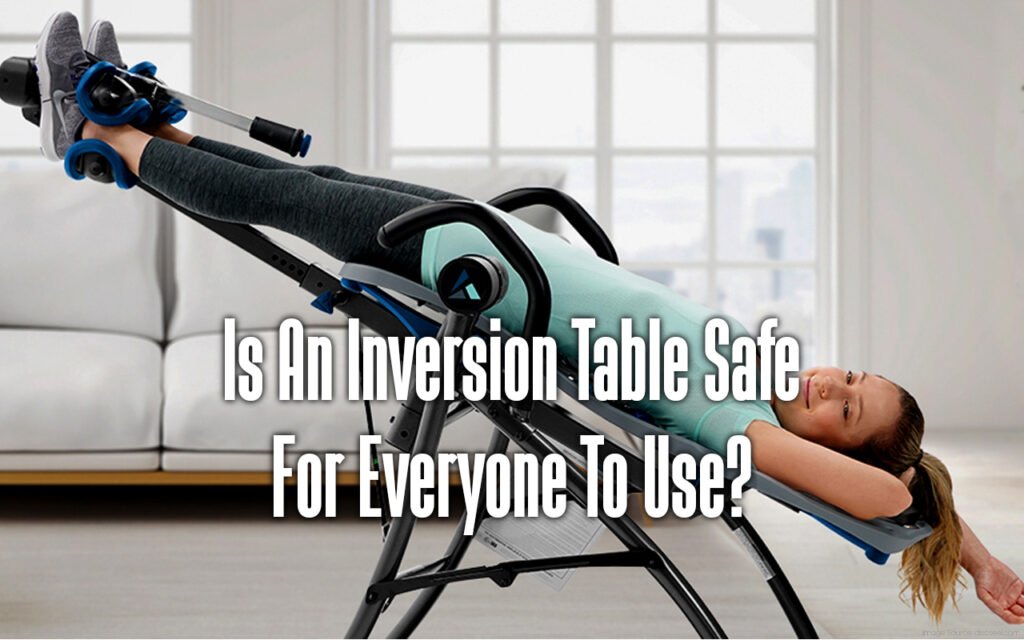Inversion tables have become increasingly popular as a potential solution for various health concerns, such as alleviating back pain, decompressing the spine, and providing stress relief. These tables offer users the ability to hang upside down at an inverted angle, with the belief that it brings about therapeutic advantages. Nevertheless, a common concern that arises is the safety of using inversion tables for everyone. Is An Inversion Table Safe For Everyone To Use? In this article, we will delve into the safety considerations surrounding inversion tables, examine their potential benefits, and identify individuals who should exercise caution or refrain from using them altogether.
Who Will Benefit From Inversion Table Therapy?
Table of Contents
Considering inversion therapy for back pain? If so, the first question on your mind might be, “Is inversion table safe?” Let’s find out! The answer is usually “Yes,” but you should always talk to your doctor first. For individuals who have undergone recent back surgery, particularly spinal fusion, it is crucial to ensure complete healing before resuming normal activities. Inversion therapy relies on a strong spine to support the full weight of your body. Wait for your doctor’s approval before using the inversion table for better safety and effectiveness. Inversion tables offer relief for a range of back issues, from alleviating pain to decompressing the spine. Reduce stress, improve blood circulation, and stretch muscles all at once. While doctors generally advise against using an inversion table during pregnancy, some pregnant women with severe back pain may find it beneficial.
The Safety of Inversion Tables: Key Considerations
Inversion tables are gaining attention for their potential to relieve back pain and improve well-being. Inversion therapy has its benefits, but it’s important to be aware of the potential risks and prioritize safety. Here are some key considerations:
1. Health Conditions and Contraindications:
Individual health status is a crucial determinant of inversion table safe. Inversion therapy may not be suitable or recommended for individuals with certain medical conditions or health concerns. It’s important to be mindful of these contraindications:
High Blood Pressure:
Inverting the body can cause a temporary rise in blood pressure. High blood pressure will pose a significant risk for individuals with hypertension. Elevated blood pressure during inversion poses risks to the cardiovascular system and may result in complications. High blood pressure individuals should avoid using inversion tables unless supervised by a healthcare professional.
Heart Disease:
Individuals with a history of heart disease or cardiovascular issues should exercise caution when considering inversion therapy. Inversion exercises can raise heart rate and workload, potentially posing risks for individuals with pre-existing heart conditions. Consulting a cardiologist or healthcare provider is advisable before attempting inversion.
Glaucoma:
Inversion tables can raise intraocular pressure, potentially aggravating glaucoma symptoms. Glaucoma is a collection of eye conditions characterized by elevated pressure within the eye. People with glaucoma should avoid inversion therapy to prevent potential harm to their eyes.
Ear Infections or Balance Disorders:
Inverting the body can cause dizziness or discomfort for those with ear infections, vertigo, or balance disorders. Inversion tables can be unpleasant or even dangerous, especially if you have certain conditions. It is recommended to avoid inversion therapy in such cases.
Pregnancy:
Inversion tables are not suitable for pregnant women, especially in the later stages of pregnancy. Inverting the body can lead to pressure on the uterus and impact blood circulation, posing risks to both the mother and the developing fetus. Pregnant women should consult with a doctor before considering inversion therapy.
Obesity:
Significant overweight can lead to increased stress on joints, spine, and circulatory system during inversion. Additional strain can worsen existing health problems and raise the risk of injury. If you are obese, it is important to consult your doctor before using the inversion table. Safety first!
2. Proper Instruction and Supervision:
Proper instruction and supervision are essential for safety when using an inversion table. Learning the correct usage is vital to prevent accidents and injuries. Beginners should gradually increase inversion angles as they get used to the feeling, starting with shallow angles.
Inversion tables usually include user manuals with safety guidelines for proper usage. Reading and following these instructions meticulously is important. For those new to inversion therapy, it’s recommended to seek guidance from a certified trainer or physical therapist. They can teach you proper techniques and ensure your safety.
3. Duration and Frequency:
Overusing an inversion table safe is only your myth or staying inverted for too long can cause discomfort and pose health risks. Start with 5-15 minute inversion sessions for safety and gradually increase the duration as your body adapts. Prolonged or excessive inversion can lead to muscle strain, joint discomfort, or negative physiological responses.
4. Quality of Equipment:
The quality and stability of the inversion table are crucial for ensuring safety during use. Choosing a reliable inversion table that meets safety standards and quality controls is essential. Beware of cheap or poorly made tables that may malfunction, potentially causing accidents and injuries.
Inspect the table on a regular basis for wear and tear, loose fasteners, or structural issues to minimize safety risks and maintain its excellent condition.
5. Age and Physical Fitness:
Age and physical fitness level are factors that affect the safety of inversion tables. Older individuals and those with lower physical fitness levels should exercise extra caution during exercise. Consult a doctor before starting inversion therapy if you have concerns about muscle weakness, joint issues, or osteoporosis. Get personalized guidance on inversion suitability and tailored health advice from experts who can assess your specific needs.
The Potential Benefits of Inversion Tables
Inversion tables are increasingly popular for their non-invasive and drug-free benefits in improving health and well-being. Ensuring safety is a top priority, but it’s also important to acknowledge the potential benefits of the appropriate use of inversion therapy. Inversion tables offer potential advantages for users, providing various benefits for improved well-being:
Back Pain Relief:
Inversion tables are frequently used to alleviate back pain, making them one of the most commonly cited reasons for their usage. Inversion therapy is a technique thought to relieve back pain by decompressing the spine, reducing pressure on the discs, and improving spinal alignment. Reducing spinal compression offers several benefits for overall health and well-being, which include:
- Spinal Decompression: Inversion tables can gently stretch and lengthen the spine & create space between the vertebrae. This can help alleviate pressure and relieve pressure on spinal discs and nerves, potentially reducing discomfort caused by conditions like herniated discs and sciatica.
- Improved Blood Circulation: Inverting can improve blood flow to the spine, which helps deliver oxygen and nutrients, supporting the healing process.
- Muscle Relaxation: Inversion tables can provide relief for muscle-related back pain by relaxing tense muscles in the back, shoulders, and neck.
- Pain Reduction: Inversion sessions have been found to alleviate pain and discomfort for many users, offering a potential alternative or complement to pain management strategies.
Improved Posture:
Regular use of inversion tables can help improve posture gradually. Inversion can improve posture by releasing tension in the muscles and ligaments around the spine, promoting spinal alignment for better standing and sitting posture. Good posture not only improves your physical appearance but also lowers the risk of posture-related health issues.
Stress Reduction:
Inversion therapy has a potential way to relax both the body and mind. Hanging upside down can boost mood by triggering the release of endorphins, natural mood enhancers. Endorphins released during physical activity can alleviate stress and promote a feeling of overall well-being. Inversion not only provides gentle stretching and relaxation but also promotes a calm and meditative state, contributing to stress reduction.
Improved Joint Health:
Inversion tables can provide benefits for joint health, especially in the hips and knees. Inversion supports joint health, which includes:
- Enhanced Joint Lubrication: Inverting can promote better flow of synovial fluid, a natural joint lubricant, within the joints. This may help decrease joint friction and stiffness.
- Improved Range of Motion: Inversion tables can improve joint flexibility, making daily activities and exercises more comfortable.
- Pain Reduction: Inversion can help relieve joint pain from conditions such as osteoarthritis by reducing the pressure on affected joints.
Enhanced Circulation:
Inverting the body can enhance blood circulation throughout the body, promoting better overall health. The benefits of enhanced circulation include:
- Improved Cardiovascular Health: Inversion therapy may promote cardiovascular health, increasing blood flow to the heart and reducing the circulatory system strain.
- Enhanced Oxygen Delivery: Improved circulation promotes the effective delivery of oxygen & nutrients to body tissues, supporting their overall health and function.
- Reduced Swelling: Inversion can help reduce swelling and inflammation in the extremities by promoting limb fluid movement.
Relief from Muscle Tension:
Inversion tables offer relief from muscle tension and spasms. Inversion, with its gentle stretching and relaxation, can provide relief for sore muscles and promote a sense of overall relaxation.
Potential for Enhanced Athletic Performance:
Athletes and fitness enthusiasts utilize inversion therapy as a component of their training routine. Inversion tables can enhance athletic performance, flexibility, and recovery by promoting spinal health and reducing muscle tension.
Better Sleep Quality:
Inversion therapy can enhance sleep quality by promoting relaxation and reducing stress. Users have reported regular inversion sessions to result in more restful and deeper sleep.
Safety Concerns
Inversion table safe and effective treatment for back pain for most people. However, individuals with certain medical conditions are advised to consult their doctor before starting any new therapies:
- Obese people
- Pregnant women
- Patients with spinal injuries
- Anyone who has had a stroke
- Those who use anti-coagulants
- Patients with retinal detachment
- Anyone with a hiatal or ventral hernia
- People with conjunctivitis or glaucoma
- Patients with circulatory problems or high blood pressure
- Patients who have weak bones or who have had recent fractures
The inversion table can occasionally pose a challenge on its own. Ensure your comfort and secure locking before any flipping begins. Start with a gradual 40° to 60° oscillation rather than diving fully upside down. Take it slow and steady, and then build up from there. Avoid hanging motionless for more than a minute once you are fully upside down. Prolonged inversions can lead to increased blood pressure and bleeding in the small blood vessels of the eyes.
Conclusion
Inversion tables are a valuable tool that can help relieve back pain and contribute to overall well-being. Approach their use with caution and be mindful of potential risks, particularly if you have underlying health conditions. Evaluate your medical history, physical condition, and any relevant contraindications. Follow guidelines, select a high-quality product, and prioritize your safety to use an inversion table safe by use it safely.
Although inversion tables can provide advantages to numerous individuals, it is important to note that they may be unsuitable for everyone due to safety considerations. Safety should be the top priority, with individuals making informed decisions based on their unique health circumstances. When used responsibly, inversion tables can greatly contribute to a holistic approach towards health and well-being.
Choosing the right inversion table is essential for improving back health and overall well-being. Looking for the best inversion tables in 2024? Check out my article ‘8 Best Inversion Tables of 2024‘ to know more about the inversion tables. Explore highly rated options to help ease back pain and improve your overall health. Click here to explore the article and make an informed choice for your inversion therapy needs.








